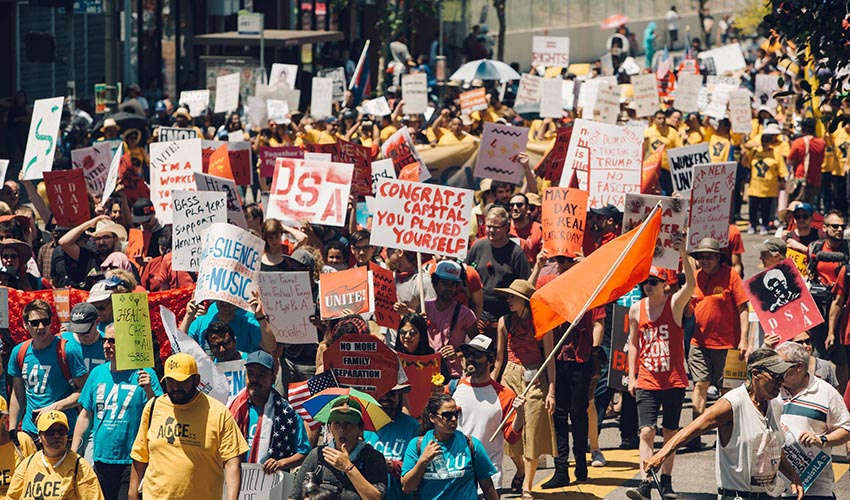State of the Union: A Q&A on the modern organized labor movement

Workers hold a May Day strike in Los Angeles in 2017. Photo Credit: (CC BY 2.0)
Labor expert explains why unions and organizing have dominated headlines in recent months, plus more

SF State College of Business Professor and Chair of Labor Studies John Logan.
John Logan is a professor and chair of the College of Business’ Labor Studies Department. He is a labor historian and an expert on the anti-union industry, anti-union legislation in the U.S. and comparative labor issues. Logan discusses labor unions, millennials in today’s job market, the middle class and recent worker strikes.
There have been a number of headlines lately about unions, such as teachers striking and journalists pushing to unionize. Why now?
What’s unique about the teachers’ strikes in West Virginia, Oklahoma and other states is they are happening in traditional Republican states where unions are weak. Second, in many of these states, public sector employees don’t have collective bargaining rights, which means they aren’t able to negotiate the terms of their contract with their employers.
The teachers’ strikes aren’t just about pay, although that is very important because teachers and other public sector employees have fallen very far behind nationally, particularly in these Republican-controlled states. They are also organizing for more resources for public education, which is probably why they have wider community support. There’s the broader issue of their professional identity being undermined and not being valued. For these particular workers — journalists, teachers and even nurses — they are doing a lot of organizing because they don’t feel respected.
Does our current labor movement echo any movements of the past?
There’s always been that continuum within the labor movement. In the 1960s and 1970s the industrial unions, like the United Auto Workers, were at the forefront of liberal politics in America and very active in the civil rights movement. In recent years, Service Employees International Union (SEIU) and Unite Here have led the progressive arm of the labor movement.
The economy is changing, so unions must change and be as organizationally flexible as possible. They need to find ways to integrate all the new groups of workers — freelancers, gig-economy workers — who want to be part of the labor movement and develop structures that are flexible enough to represent them. These structures won’t look like the big old industrial unions of the ’30s and ’40s. The continuity is that unions are the institutional embodiment of peoples’ notions of just treatment at the workplace, something that hasn’t changed.
How has the recession impacted how millennials view unions?
We used to be told that young workers looked at unions favorably in theory, but they didn’t think they were particularly relevant to their lives. Young workers tend to work in young workplaces, which are overwhelmingly non-union, or they work under employment relationships, like freelancing, consulting, part-time work, the gig-economy, etc., where it’s difficult to form stable organizations like unions.
Young people entering the labor market now are much less likely to be employed by a company where there’s an expectation of a long-term, open-ended employment contract. Full-time, stable, secure work is not the type of thing young people experience. So workplace instability is causing some to think there is a need for organizations to advocate on their behalf, whether it’s traditional unions or some type of new organization that represents workers.
While the overall picture seems bleak, there are all these inspirational stories of hotel workers, restaurant workers, car wash workers and fast food workers organizing. A few years ago, no one thought these groups could be organized because of the demographics of the workplace, the high turnover rates and they were not protected by existing labor laws; yet we’ve seen new and imaginative ways to integrate these people into what’s broadly defined as the labor movement.
Middle-class wages have stagnated for a long time. How closely is this linked to the decline in union membership?
Wage stagnation is significantly linked to the decline in union membership and also to the disappearance of the kind of jobs where union membership was a normal fact of life. Manufacturing jobs had high union membership, and there have been significant job losses there. Some of those jobs disappeared and were replaced by low-wage, non-union jobs.
Deregulation and privatization of industries have led to the degradation of wages and working conditions. But if you look at it comparatively, the decline of unions and the decline of collective bargaining is a global phenomenon, a decline that’s steeper in the U.S. than in most other rich democracies.